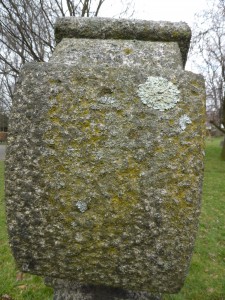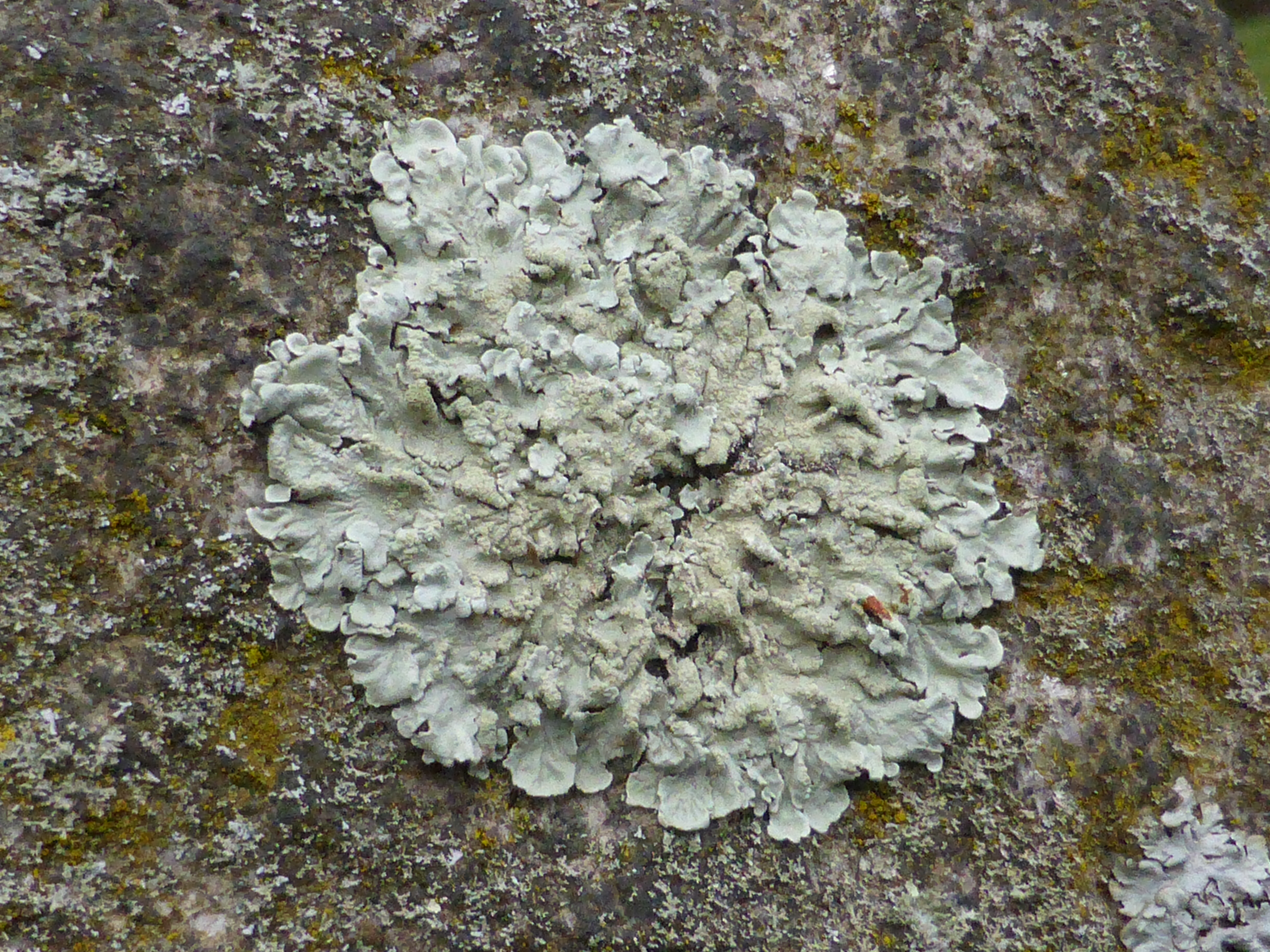 This year the first expert identification of lichens was carried out.
This year the first expert identification of lichens was carried out.
Ishpi Blatchley, our expert, made an initial survey and then took a small group round to show us what she had found in her 2 hours in the cemetery. We learnt that each lichen is really 2 organisms not one – a fungus (which has shape and form – usually producing spores) living with and providing physical protection for one or more algae which carry out photosynthesis and produce food for both.
Ishpi took us to a humble looking tree that had 15 different species of lichen on its bark with branches conveniently at the right height for inspection!
The majority of lichens were no more than a few centimetres in diameter and in a wonderful range of colours – almost luminous green to soft sea-green to bright yellow ochre. Their world really came alive on using a lens – fruiting bodies (fruits) in different shapes and colours, some resembling little jam tarts.
We learnt about the three main groups of lichen: crustose, foliose and fruticose. The crustose (crusty) ones were very much ‘stuck’ to the bark and no amount of scraping with a fingernail could dislodge them. In contrast the foliose (‘leafy’) ones had delicate little lobes that could be dislodged. The fruticose (bushy) lichens were very much 3D – quite bushy and much less common in the cemetery.
Identification relies on putting them into their 3 main groups – looking at their growth form, their fruiting bodies, and colour. Where they choose to grow if on grave stones is also relevant– some preferring acid stones (e.g. granite or sandstone) and some more basic stone (ie limestone). Ishpi did some simple tests in the field but others needed to be identified under a microscope.
Some of those we were shown included: Psilolechia lucida, Lecanora muralis, Lecanora campestris, Lecanora chlarotera, Lecidella elaeochroma, Xanthoria parietina, Xanthoria calcicola, Parmelia sulcata.
| Lichens recorded in Margravine Cemetery TQ 240782 (covers 2 monads) 25/01/2016 Ishpi Blatchley | |||||
|---|---|---|---|---|---|
| Lichen name | Cons Eval | Substrate | Sm scale habitat | Abundance | Comments |
| Aspicilia contorta subsp. contorta | LC | Sax | lm cht | A/O | |
| Bilimbia sabuletorum | LC | Bry | A/R | ||
| Buellia aethalea | LC | Sax | sd cr | A/O | |
| Buellia ocellata | LC | Sax | gr cr | A/R | |
| Caloplaca arcis | LC NS | Sax | lm cht | A/R | |
| Caloplaca citrina s. lat. | LC | Sax | lm hd | A/F | |
| Caloplaca dichroa | LC NS Sc | Sax | lm hd | A/F | |
| Caloplaca flavescens | LC | Sax | lm cht | A/O | |
| Caloplaca flavocitrina | LC | Sax | lm cht | A/O | |
| Caloplaca oasis | LC | Sax | lm hd | A/F | |
| Caloplaca saxicola | LC | Sax | lm hd | A/R | |
| Candelariella aurella f. aurella | LC | Sax | lm, STa | A/F | |
| Candelariella reflexa | LC | Cort | CPr | A/O | |
| Candelariella vitellina f. vitellina | LC | Sax | gr cr | A/F | |
| Catillaria chalybeia var. chalybeia | LC | Sax | br | A/R | |
| Cladonia chlorophaea s. lat. | LC | Sax | sd hd | A/R | |
| Cladonia coniocraea | LC | Terr | gr ch | A/R | |
| Collema crispum var. crispum | LC | Sax | lm pav | A/R | within kerbed grave |
| Collema tenax var. tenax | LC | Sax | lm pav | A/R | within kerbed grave |
| Diploschistes muscorum | LC | Lic | A/R | assoc with Clad coniocraea | |
| Flavoparmelia caperata | LC | Cort+Sax | CPr, gr cr | A/O | |
| Flavoparmelia soredians | LC Sc | Cort | CPr | A/R | |
| Hyperphyscia adglutinata | LC | Cort | CAe | A/F | |
| Hypogymnia physodes | LC | Cort | CPr | A/R | |
| Hypotrachyna revoluta s. lat. | Cort | CPr | A/O | ||
| Lecania inundata | LC NS | Sax | gr kb | A/R | |
| Lecanora albescens | LC | Sax | lm | A/F | |
| Lecanora chlarotera | LC | Cort | CFx | A/O | |
| Lecanora dispersa | LC | Sax | lm cht | A/F | |
| Lecanora expallens | LC | Cort | CFx | A/R | |
| Lecanora muralis | LC | Sax | gr cr, STa | A/F | |
| Lecanora polytropa | LC | Sax | gr kb | A/O | |
| Lecidella elaeochroma f. elaeochroma | LC | Cort | CFx | A/F | |
| Lecidella stigmatea | LC | Sax | lm, STa | A/O | |
| Lepraria incana s. str. | LC | Sax | sd cr | A/O | |
| Melanelixia fuliginosa | LC | Sax | gr cr | A/R | |
| Melanelixia glabratula | LC | Sax | gr cr | A/O | |
| Melanelixia subaurifera | LC | Cort+Sax | gr cr, CPr | A/F | |
| Parmelia sulcata | LC | Cort+Sax | sd cr, CPr | A/O | |
| Parmotrema perlatum | LC | Cort | CPr | A/O | |
| Peltigera hymenina | LC | Terr | A/R | ||
| Phaeophyscia orbicularis | LC | Sax | lm hd | A/F | |
| Physcia adscendens | LC | Cort+Sax | CPr, lm hd | A/F | |
| Physcia caesia | LC | Sax | STa, lm hd | A/O | |
| Physcia dubia | LC | Sax | sd hd, gr hd | A/O | |
| Physcia tenella | LC | Cort | CPr | A/O | |
| Porpidia tuberculosa | LC | Sax | sd hd | A/O | |
| Protoblastenia rupestris | LC | Sax | lm hd | A/O | |
| Psilolechia leprosa | LC M* | Sax | gr cr Cu ro | A/R | |
| Psilolechia lucida | LC | Sax | sd hd | A/O | |
| Punctelia jeckeri | LC | Cort | CPr | A/O | |
| Ramalina farinacea | LC | Cort | CPr, CFx | A/R | very small thalli |
| Rhizocarpon reductum | LC | Sax | gr cr, sd hd | A/F | |
| Scoliciosporum umbrinum | LC | Sax | sd cr | A/O | |
| Trapelia coarctata | LC | Sax | sd cr | A/R | |
| Placopyrenium fuscellum | LC | Sax | lm hd | A/R | |
| Verrucaria nigrescens f. nigrescens | LC | Sax | lm cht | A/F | |
| Xanthoria calcicola | LC | Sax | lm urn | A/R | |
| Xanthoria candelaria s. lat. | LC | Cort+Sax | CPr, gr cr | A/O | |
| Xanthoria parietina | LC | Cort+Sax | CPr, lm hd | A/F | |
| Xanthoria polycarpa | LC | Cort | CPr | A/R | |
| Lecanora compallens | LC NS | Cort | CPr | A/R | |
| Candelaria concolor | LC | Cort | CPr | A/R | |
| Illosporiopsis christiansenii | LC NS | Lic | A/R | on Physcia sp | |
| Cladonia squamosa s. lat. | Terr | A/R | K+y-r | ||
| Amandinea punctata | LC | Cort | CPr | A/O | |
| Porpidia crustulata | LC | Sax | sd | A/R | |
| Xanthoparmelia mougeotii | LC | Sax | sd base to gr hd | A/R | John Vivian mem |
| Caloplaca crenulatella | LC | Sax | sd kb,co slab | A/O | |
| Catillaria lenticularis | LC | Sax | lm hd | A/O | |
| Lecanora campestris subsp. campestris | LC | Sax | lm hd | A/O | |
| Physconia grisea | LC | Cort | A/O | london plane | |
| Conservation Evaluation | LC | Least concern | |||
| NS | Nationally scarce | ||||
| Sc | in Scotland | ||||
| Substrate | Cort | on trees | |||
| Sax | on stone | ||||
| Bry | over mos | ||||
| Terr | on earth | ||||
| Lic | on other lichen | ||||
| Small scale habitat | hd | headstone | |||
| kb | kerb | ||||
| cht | chest | ||||
| cr | cross | ||||
| cu ro | copper runoff | ||||
| lm | limestone | ||||
| sd | sandstone | ||||
| gr | granite | ||||
| co | concrete | ||||
| br | brick | ||||
| STa | asphalt path | ||||
| Pr | Prunus | ||||
| Fx | Fraxinus |

